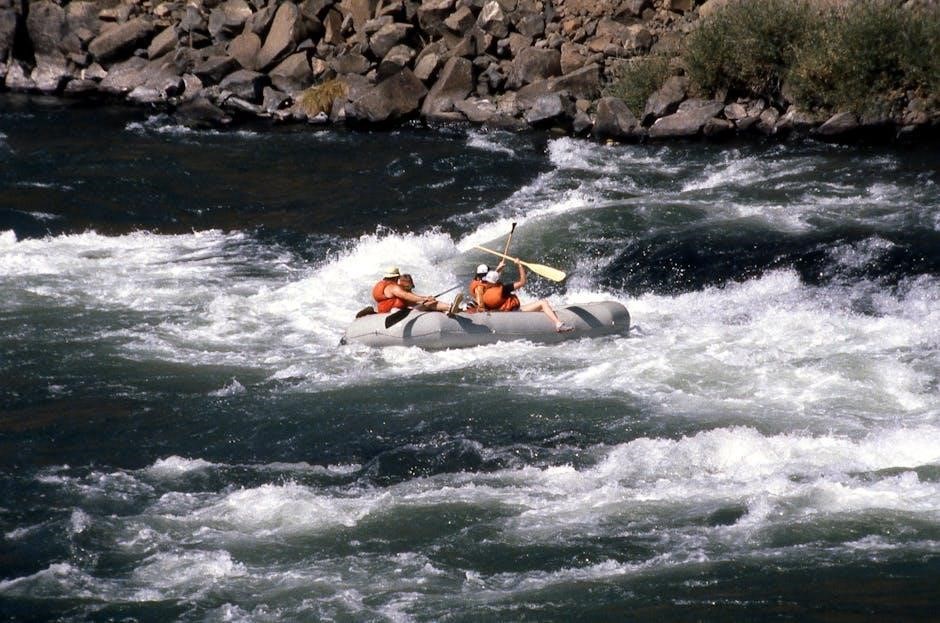Tipping your rafting guide is a thoughtful way to show appreciation for their expertise, safety measures, and efforts to enhance your adventure experience on the water.
Why Tipping Your Rafting Guide Matters
Tipping your rafting guide is a meaningful way to express gratitude for their expertise, safety measures, and efforts to make your adventure memorable. Guides often go above and beyond, ensuring not only your safety but also enhancing your overall experience with their knowledge of the river, wildlife, and local history. A tip reflects appreciation for their hard work, dedication, and ability to handle unexpected challenges, such as navigating tough rapids or addressing emergencies. It also acknowledges the time they invest in preparing equipment, sharing stories, and creating a positive atmosphere. Tipping is not mandatory but is widely recognized as a standard practice in the industry, showing respect for their professionalism and commitment to providing an exceptional experience.

Factors Influencing Tip Amounts
Tip amounts for rafting guides are influenced by service quality, trip duration, complexity, and group size. Regional norms and overall satisfaction also play a role in determining appropriate gratuities.
The expertise and service quality of your rafting guide significantly impact the tipping amount. Guides who demonstrate exceptional skill, ensure safety, and enhance your experience with engaging storytelling or personalized attention deserve higher tips. If the guide goes above and beyond, such as handling challenges smoothly or providing extra insights, it reflects their dedication. Conversely, if the service is subpar, tips may be adjusted accordingly. A guide’s ability to manage the group, navigate tricky waters, and create a memorable adventure is crucial. Their professionalism and friendliness also play a role in determining gratuity. Always consider their overall contribution to your trip’s success when deciding the tip. The length and complexity of your rafting trip are key factors in determining the tip amount. Longer trips, such as multi-day adventures, require more effort and dedication from guides, who often work tirelessly to ensure a safe and enjoyable experience. For half-day or full-day trips, the tip amount may be smaller compared to extended journeys. However, if the trip involves challenging rapids or requires exceptional navigation skills, the tip should reflect the guide’s expertise. A general rule is to increase the tip for longer or more physically demanding trips, as guides invest more time and energy into ensuring your safety and satisfaction. Always consider the overall demands of the trip when deciding your gratuity. When determining how much to tip your rafting guide, consider the size of your group and individual contributions. Larger groups often split the tip collectively, while smaller groups may find it easier to contribute individually. A common approach is to tip based on a per-person amount, with recommendations ranging from $10 to $20 per person for a day trip, depending on the experience. If you’re part of a group, discuss and agree on a fair contribution to ensure the tip reflects everyone’s satisfaction. While it’s customary to pool tips, some individuals may choose to add extra if they feel the service exceeded expectations. Always communicate openly with your group to ensure a fair and generous gratuity for your guide. Average tips range from 10% to 20% of the trip cost, with $20-$40 per person for full-day trips and $10-$20 for half-day adventures. For half-day rafting trips, tipping $10 to $20 per person is standard, while full-day trips typically see tips ranging from $20 to $40 per person. These amounts reflect the guide’s expertise and the quality of service provided. If the trip cost is $200 per person, a 10% to 20% tip ($20 to $40) is appropriate. Some sources suggest tipping based on the total trip cost, ensuring fairness for group sizes. Tips can also vary depending on the guide’s performance and how they enhance the experience. These guidelines help ensure your gratitude is expressed fairly, acknowledging the guide’s hard work and dedication to safety and enjoyment. For multi-day rafting adventures, tipping ranges from $10 to $15 per person per day, totaling $20 to $30 or more for a two-day trip. This reflects the guide’s continuous effort, including setting up camp and ensuring safety over extended periods. Some recommend tipping 10% to 20% of the total trip cost, especially if the guide exceeds expectations. For a $200 multi-day trip, a $20 to $40 tip per person is appropriate. Group contributions should be pooled to avoid individual tipping confusion. These guidelines ensure fair compensation for guides who work tirelessly to make your multi-day rafting experience memorable and safe. Your generosity is a great way to show appreciation for their dedication. Tipping your rafting guide based on a percentage of the total trip cost is a common and straightforward approach. For most rafting adventures, a gratuity of 10% to 20% of the total cost is considered standard. This means if your trip costs $200, a tip of $20 to $40 is appropriate. Some recommend tipping 15% to 25% for exceptional service, reflecting the guide’s expertise and effort. This percentage-based method ensures the tip aligns with the trip’s overall value and your satisfaction. It’s a simple way to show appreciation for a memorable and safe experience. Always adjust the percentage based on the quality of service and your personal comfort. Tipping customs for rafting guides can vary significantly depending on the region and cultural norms. In the United States, for instance, tipping between 10% to 20% of the trip cost is standard, reflecting the service industry’s tipping culture. However, in other countries, such as those in Europe or Asia, tipping practices may differ. Some regions may expect lower percentages or even flat rates, while others might not have a strong tipping tradition at all. Additionally, local economic conditions and the cost of living can influence tipping amounts. Always consider the regional customs and the guide’s expectations when determining how much to tip. This ensures your gratitude is appropriately expressed in different parts of the world. Planning for tips ahead of time ensures a smooth and stress-free experience during your rafting adventure. Based on the total cost of your trip, allocate 10% to 20% for gratuities, as this range is commonly recommended. For example, if your half-day trip costs $100, budget $10 to $20 for the guide. For multi-day excursions, calculate the tip based on the overall price. Setting aside a portion of your trip budget for tips avoids last-minute financial strain. Consider factors like service quality and trip complexity when deciding the exact amount. This proactive approach ensures you’re prepared to show appreciation for your guide’s efforts without compromising your financial planning. Budgeting for tips in advance is a considerate way to honor their dedication and expertise. In private or luxury trips, consider tipping 20% or more, as personalized service often warrants higher gratuities. If service exceeds expectations, increase the tip; if it falls short, adjust accordingly. For private or luxury rafting excursions, tipping practices often differ due to the personalized nature of the experience. Guides on these trips typically provide elevated service, including tailored itineraries, gourmet meals, and exclusive access to remote locations. Given the higher cost and enhanced amenities, tipping percentages tend to increase. A common recommendation is to tip between 20% to 30% of the total trip cost, reflecting the premium service received. Additionally, some guests may choose to tip each guide individually if multiple staff members contributed to the experience. This ensures that all crew members are recognized for their efforts. If your rafting guide surpasses expectations with exceptional service, safety, and enthusiasm, consider tipping on the higher end of the spectrum, around 20-25% of the trip cost. Conversely, if the service is subpar or unprofessional, it’s appropriate to adjust the tip downward, potentially below the standard range. Some guests opt to leave a smaller amount or even forgo tipping entirely in cases of poor service. However, it’s courteous to communicate feedback directly to the guide or tour operator rather than simply withholding a tip. This approach fosters understanding and improvement. Remember, tipping should reflect the quality of service and your overall satisfaction with the experience. The rafting industry generally recommends tipping between 10% to 20% of the total trip cost as a standard gratuity for guides. This percentage reflects the guide’s role in ensuring safety, providing expertise, and enhancing the overall experience. For half-day or full-day trips, tipping $10 to $20 per person is common, while multi-day adventures often see higher amounts, around $15 to $30 per person. These guidelines are widely accepted across the industry and serve as a benchmark for showing appreciation for exceptional service. Adjustments can be made based on individual experiences, but adhering to these standards ensures fair compensation for guides. Tipping your rafting guide is a meaningful way to express gratitude for their hard work and dedication to ensuring a safe and enjoyable experience. While there’s no strict rule, industry standards suggest tipping 10% to 20% of the trip cost, with adjustments based on service quality and trip length. For half-day trips, $10 to $20 per person is typical, while multi-day adventures may warrant $15 to $30 or more. Regional norms and group sizes can influence these amounts, but the key is to tip what feels fair for the value received. Remember, tipping is voluntary but highly appreciated, as it reflects the guide’s impact on your adventure. How much should I tip my rafting guide?Service Quality and Guide Expertise
Trip Duration and Complexity
Group Size and Individual Contributions
Average Tip Amounts for Rafting Guides
Half-Day and Full-Day Trips
Multi-Day Rafting Adventures
Percentage-Based Tipping Guidelines

Regional Variations in Tipping Norms
Budgeting for Tips in Advance

Special Cases and Exceptions
Tipping for Private or Luxury Trips
When Service Exceeds or Falls Short of Expectations

Industry Recommendations and Standards
Frequently Asked Questions
Typically, tips range from 10% to 20% of the trip cost, depending on service quality and trip duration. For half-day trips, $10 to $20 per person is common, while multi-day trips may warrant $15 to $30 or more per person.
Do I tip per person or per group?
Tips are usually per person, as this reflects individual contributions to the experience. However, group tips can be pooled if everyone agrees.
What if the service was exceptional or disappointing?
If service exceeded expectations, consider tipping on the higher end or adding a small extra amount. Conversely, if service was poor, tipping on the lower end is appropriate.
Are there regional tipping differences?
Yes, tipping norms can vary by location. Always check local standards or ask your tour operator for guidance to ensure your tip is appropriate.